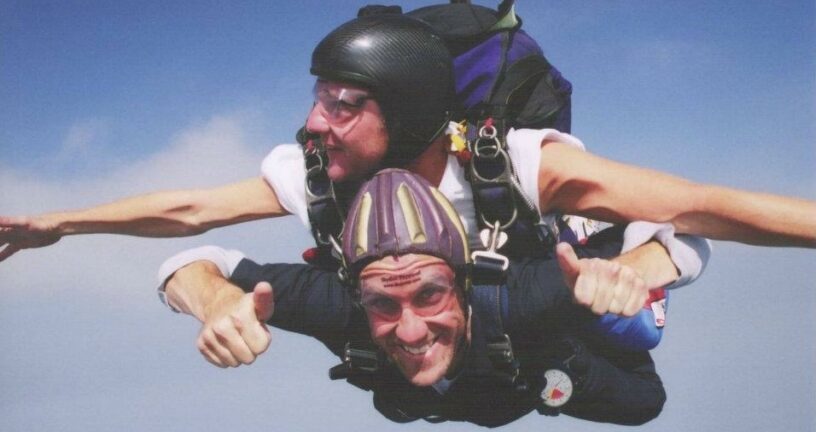I’m a competitor at heart.
I love the thrill of a good race with daunting odds and plenty of obstacles, and even if I don’t win or run as far or as fast as I had hoped this time, you can bet I’ll be back again for more.
The Gallup Organization’s CliftonStrengths is a survey that helps people identify some of their natural talents and develop them into strengths. Not surprisingly, according to Gallup, “Competition” is one of my leading strengths, and I will often frame a difficult challenge as an opportunity for goal-setting, overcoming odds, and beating expectations.
However strong my body, my determination, and my natural urge to compete may be, though, there is one challenger, close at my heels, I am racing harder than ever right now to beat.
For most of the past twenty years, I have lived each day with the knowledge, somewhere in the back of my mind, that at any moment my heart could either race wildly out of control, or simply burst, ending my life almost instantly.
It has not been something I think about all the time, and for many of those years, until very recently, my condition has been quite stable. If anything, the occasional glimpses I have had at my own mortality have caused me to work harder and to strive even more as a leader, as an athlete, as a husband and as a father.
The time we have, however much of it we are granted, is precious, and I’ve always felt driven to make the most of it.
The Runaway Heart
My sometimes-errant heart first tried to take off without me the morning of March 20, 2003.
It was the day that the United States and a coalition of allies began the “shock and awe” bombing campaign that launched the Iraq War.
It was also a Thursday, which meant breakfast at our local Boys and Girls Club and the weekly meeting of the Auburn Hills, Michigan chapter of Optimist International.
I was our chapter’s president, and we began each meeting with the Pledge of Allegiance, followed by a plate of Henry Knight’s homemade waffles, while hearing from a guest speaker, then spending a little time planning programs for local youth and seniors, and enjoying each other’s company.
That morning, much of our breakfast conversation was about the invasion of Iraq, whether we would find any “WMD’s” or “weapons of mass destruction” there, and the dangers posed to the world by al-Qaeda, which less than two years before, on September 11, 2001, had struck a horrific blow on U.S. soil.
An hour later, as we all stood up to end our meeting by reciting the Optimist Creed together, the room suddenly started spinning, and my vision began to get blurry. I could feel my heart racing in my chest for a few terrifying seconds as I tightly gripped the back of my chair to keep from falling.
Then, just as quickly as the strange feeling came over me, it vanished, and I was fine.
No one had even noticed.
With all the confidence of a thirty-something-year-old in pretty good shape who didn’t grapple with health challenges and still had a twenty-something-year-old’s lingering sense of invulnerability, I chalked it up to too much coffee and war-talk, got in my car, and drove to work.
Over the next few weeks, though, I began to experience more of those light-headed episodes during which my heart would seem to “flutter,” and it became obvious, even to me, that something was wrong.
My doctor referred me to a cardiologist, who strapped a “holter monitor” on me, which I wore for a couple of days, then returned to his office around 3 o’clock one afternoon.
Shortly after 5 o’clock I flipped open my phone (yes, flipped, this was 2003) and answered a call from the cardiologist, who calmly informed me that I was having episodes of “ventricular tachycardia” during which my heart was racing up to 300 beats per minute—more than three times as fast as a normal heartbeat.
He said that, given the “self-limiting” nature of the episodes and the intervals in between each one, I probably wasn’t in immediate danger of cardiac arrest, but these “arrhythmias” were nothing to fool around with, and I needed to see him first thing in the morning for further testing.
In the span of forty-eight hours, my life, or at least my perspective on it, dramatically changed, and already I was learning a new vocabulary for my new existence: words like “holter”, “tachycardia”, and “arrhythmia.”
Over the next few months, while teams of physicians, cardiologists, and researchers in Michigan, Massachusetts, and eventually at Johns Hopkins Hospital in Maryland (it turned out I was a medical oddity worthy of studying) tried to figure out why my heart was suddenly misfiring, I learned more:
“Ventricular tachycardia” or “VT” is a type of arrhythmia, or abnormal heart rhythm, caused by the lower chambers of the heart, the “ventricles,” beating too quickly to pump blood properly, which can result in light-headedness, fainting, and, eventually, lead to cardiac arrest and death.
It’s kind of like an electrical short-circuit, but instead of your toaster or your television, it’s your heart.
While episodes of ventricular tachycardia typically affect those with some kind of existing heart disease, a small number of people like me with otherwise seemingly healthy hearts, just under 10% of those with the condition, can also experience symptoms, known as “idiopathic ventricular tachycardia” or “IVT,” which, if not treated, can be just as deadly.
Caught and treated in time, the outcome can be full, symptom-free recovery.
A Shocking Experience
As it turned out, IVT did show up from time to time in athletes, particularly those who, like me at the time, were experiencing new or more significantly challenging physical fitness routines: I had been piling on miles to my long-distance running, and preparing to compete in my first triathlon.
Just a few months before my IVT began, and only a few miles down the street from me, Detroit Lions rookie quarterback, 24-year-old Joey Harrington, left the field during a game because of a rapid heartbeat. Cardiologists performed an “ablation,” a procedure which involves inserting a catheter through an artery and into the heart to burn away tissue that is causing electrical misfires.
It worked, and while Harrington did not return for the last two games of the Lions’ dismal 3-13 season, he was back in practice for spring training and played five more seasons as a starting quarterback in the NFL.
It was with Harrington’s heroic story fresh in my mind that, a few months after trying a variety of medications and modest dietary changes to no avail, I agreed to undergo the same ablation procedure that cured Harrington.
It was both unsettling and amazing. For people like me, with unpredictable IVT, the preferred approach is for the patient to be awake in a “twilight” state during the procedure, while a catheter delivers a variety of chemicals and electrical currents to different parts of the heart in an attempt to identify the malfunctioning areas and “ablate” them so the heart can pump normally again.
Unfortunately, despite going at it for a couple of hours, the doctors were only able to isolate and ablate a couple of small areas that, we discovered afterward, were not raising all the ruckus.
It didn’t work.
My IVT episodes continued, and a few months later I was faced with the prospect of Plan B: Installing an implantable cardioverter defibrillator, or “ICD” device in my chest, with lead wires attached to my heart, monitoring it and, if necessary, delivering a shock nearly 1,000 volts strong, almost ten times the voltage of a typical household electrical outlet, to jolt my heart back into a normal rhythm.
I was thirty-six years old, and otherwise a fit, healthy man. The thought of having a pacemaker/defibrillator implanted in my chest to correct my misbehaving heart, most likely for the rest of my life, seemed mighty grim.
But my youngest daughter, Zoë, had just been born, and I wanted to be there for her and her sister, Thomasina, to enjoy the wonders of their childhood, and to someday hold my grandchildren, even if it meant I needed to become a bionic man to make it happen.
So, in the summer of 2004, cardiologists performed another ablation, seeking to once and for all mend my troublesome ticker, and just to be sure, they implanted an ICD, wired to my heart, ready to shock it back into rhythm the next time it tried to run away from me.
I hadn’t even left the hospital yet when the competitor in me kicked in.
Soon after that second ablation and with the scars on my chest from the ICD still healing, I went back to training and in the spring of 2005 competed in a triathlon as a fundraiser for my Optimist Club.
The good news is that this time around the ablation seemed to have worked. My arrhythmias settled down, that triathlon led to more athletic competitions and, other than avoiding metal detectors at the airport, I resumed a normal lifestyle again.
The bad news is, two years after it was implanted, the cardioverter defibrillator malfunctioned and started randomly delivering electrical shocks to my heart.
Yes, that is just as terrible as it sounds.
Thankfully, I managed to get to a hospital and have the device turned off before it turned me off, and not long afterward, with the somewhat-hesitant support of my family and physicians, I had the thing removed for good.
Joining the Zipper Club
Since then, I have hiked the 48 4,000-footers of New Hampshire, trekked around the Canadian Rockies, across the Tetons, and to the top of Mount Kilimanjaro in Tanzania.
I have run countless 5K and 10K races, along with several half-marathons and 200-mile relays.
I have kayaked the 117-mile length of the Merrimack River, jostled with fellow gladiators in Spartan Races and the Tough Mountain Challenge, competed with my brother and sister in the Tuckerman’s Pentathlon Inferno, and, only because she lost a bet and was good for her word, toted my wonderfully indulgent wife, Estonian-style, through an obstacle course, and up and down a mountain, in the Sunday River International Wife Carrying Championship.
Around my house, we have a saying about me, borrowed from the wall of a local canine kennel: “A tired dog is a good dog.”
I don’t sit still much.
But I am going to have to learn how, at least for a little while.
Because while my life-threatening ventricular tachycardia seems to have been largely cured by that second ablation, I still have occasional “flutters” of arrhythmias. And not long ago, during a routine check-up for some of those flutters, my cardiologist discovered a sizable aortic aneurysm that, it turns out, I was born with and has been slowly but steadily growing above my heart for decades.
Left alone, like a bulge on the side of a bicycle tire, it will someday rupture.
So, to avoid that unpleasant experience, particularly out on the far reaches of some remote mountaintop, and because I still want to be here for my wife and daughters, and to someday hold my grandchildren, a few days from now I am having open-heart surgery to replace my bulging ascending aorta with a synthetic graft.
I’ll admit, even the competitor in me is a bit daunted by this one.
Seeking hope on the horizon, I went in search of a story like Joey Harrington’s, the rookie Lions QB with the ablated heart, and discovered there is actually a small fraternity of professional basketball players who were sidelined by aneurysms and other ailments, and returned to the NBA after open-heart surgeries.
They call themselves the “Zipper Brothers” (for the zipper-like scars on their chests) and one of them, former Boston Celtic Jeff Green, helped lead the Cleveland Cavaliers to the NBA Championship Finals in 2018, six years after his surgery.
I’ve never had a great jump shot, and at 5’-11” I’m considerably shorter than the average pro basketballer, but if that’s the kind of training that leads to a full rebound, I’ll give it a go.
For now, though, I am told that for several weeks after my surgery, besides feeling some pain and discomfort, I will tire easily, may be irritable, cannot lift heavy weights, and should avoid strenuous exercise.
So, no mountaineering, long-distance paddling, or ultra-marathon running; and, much to my better half’s delight and appreciation, definitely no wife-carrying.
I will be taking a short break from “Running the Campus” and will be mostly out of touch for a while.
According to my surgeon, given my age and fitness level, six weeks after the procedure I should be back to around eighty percent of my physical abilities. At six months, I should reach ninety percent, and a year afterward, if I take care of myself and work toward my recovery, as I intend to do, I should be back to some kind of normal.
Climbing to New Heights
Down in the Andes range of Argentina, Mount Aconcagua, at 22,838 feet, is the tallest mountain in the world outside of the Himalayas, and Mount Everest, in Asia.
Climbing season for Aconcagua is short, mostly running from December to January each year, during the peak of austral summer in the Southern hemisphere.
My brothers, Mitch, Adam, and I are aiming to fly south after Christmas next year and summit Aconcagua in January 2024, a year and two months after the chief of cardiac surgery at Massachusetts General Hospital replaces my bulging aorta with that synthetic graft, so my heart can keep the blood flowing where it needs to go, even near the top of the world.
This competitor’s heart will be eager for the next challenge.






